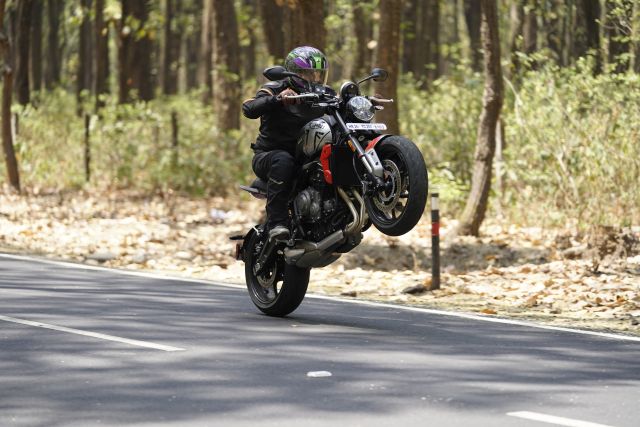
We spend a day and over 220 kilometres with the Triumph Trident, the British marque’s latest entry-level roadster.
Story: Anosh Khumbatta
Photography: Sanjay Raikar
Ever since news of Triumph building an all-new entry-level roadster broke, we have been waiting to get our hands on what is, for all practical purposes, the spiritual successor to the legendary Street Triple 675. The current Street Triple range in its 765-cc avatar boasts extremely sophisticated, specialised and sporty motorcycles that can be a handful for first-time big bike buyers; the Triumph Trident steps in to take the Street Triple 675’s place as the approachable, uncomplicated, unintimidating entry-level naked bike in the British brand’s line up. Priced at Rs 6.95 lakh (ex-showroom), it is also the easiest route to Triumph ownership.
I definitely like how this bike looks. In a world where modern motorcycles look more and more like flying machines, the Triumph Trident’s uncluttered design is a breath of fresh air. The teardrop-shaped tank leads back to a minimalistic tail section and single-piece seat, while further down a trio of shiny pipes exit the engine and lead to the stubby, under-slung exhaust system. The minimalistic approach gives the Triumph Trident an air of pure motorcycling fun, and that exactly what this bike is all about. It looks the part of a purposeful naked roadster; getting up close, paint and finish levels look top-notch and build quality seems in line with other, more expensive Triumphs.
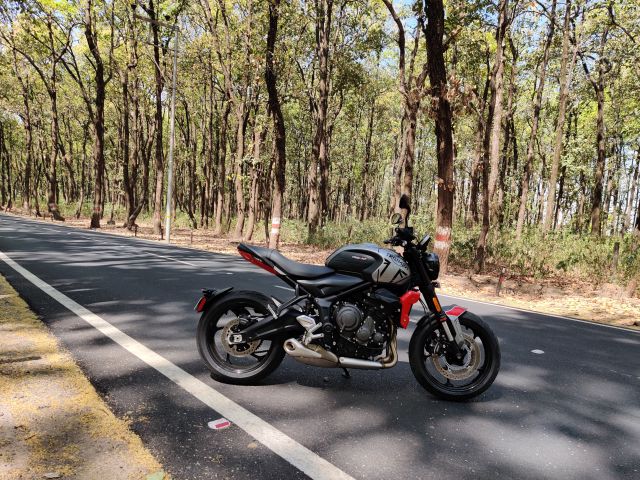
From the moment you settle into the 805-mm high saddle the bike feels compact and friendly. Setting off, it perfectly fits my 5’5” frame, and I’ve been told by taller riders that they were equally comfortable. Its slim profile enhances the manageable feel, and my thighs are snug against the textured finish of the well-designed knee recesses. The Triumph Trident feels agile and easy to live with around town, although the limited steering lock can make tight manoeuvres and U-turns a pain. The mid-set footpegs are high enough to allow for generous lean angles while not feeling cramped even after a day in the saddle.
![]()
The Triumph Trident 660 is held together by a tubular steel perimeter frame and is powered by a juicy 660-cc inline-triple. The motor is, as you might have guessed, derived from Triumph’s award-winning 675-cc three-cylinder mill from the Daytona and Street Triple. It shares the 675’s 74-mm bore with stroke reduced from 52.3 mm to 51.1 mm, bringing displacement down to 660 cc. But a lot more has gone into transforming this motor from racetrack-dominating screamer to the easygoing, tractable chugger within the Triumph Trident. The crankcase castings, oil sump, cylinder head, camshafts, crankshaft and pistons are just a few of the 67 new components that have gone into developing the Trident’s powertrain, which is why calling this motor anything other than an all-new unit would be doing it a great disservice.
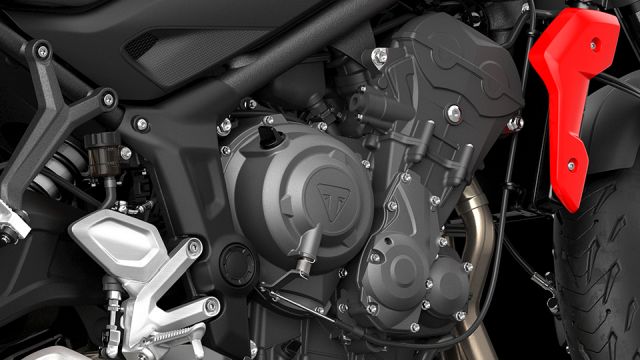
Peak figures are 81 hp at 10,250 rpm and 64 Nm at 6,250 rpm and, while this doesn’t seem like a lot of power on paper, it is the way it is delivered is what makes this bike so exciting to ride. The motor churns out 90 per cent of peak twist from as low as 3,600 rpm, and pulls the Triumph Trident forward with urgency just about anywhere in the rev range. You could putter around town at 40 to 50 km/h in sixth without a hint of knocking and accelerate away smoothly, or enter corners in a gear too high and still get excellent drive through; but more entertaining is how the motor feels when you wring it out across open sections of road. Things start getting lively upwards of 4,000 rpm, and by the time the tacho gets past 6,500 rpm you’ll be holding on tight and grinning wide as that raspy exhaust note builds to a howling crescendo. 81 horses feel like a lot when backed up by a strong wave of torque and accompanied by the triple’s addictive soundtrack. Shifts through the six-speed gearbox were always positive during my ride, and the first four short ratios perfectly complement the engine’s character, contributing greatly towards the Triumph Trident’s rapid acceleration through the gears.
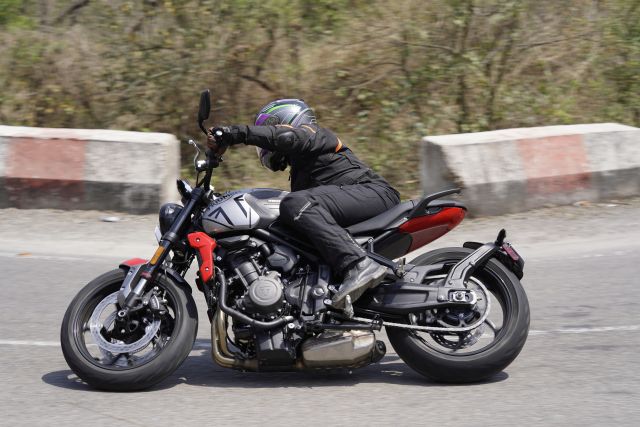
When compared to the more premium bikes in Triumph’s line-up, the suspension and brake components on the Trident definitely seem like budget items; the Showa upside-down fork is quite basic and lacks any adjustability, the monoshock only gets a preload collar and the Nissin brakes are a far cry from the Brembo monoblocs that do duty on most higher-end British machines. Sure the Triumph Trident is built to a cost, but don’t let anyone tell you that these components limit this motorcycle’s abilities to show you a good time. Both ends felt extremely well-damped, even with the pace turned up through the twisties.
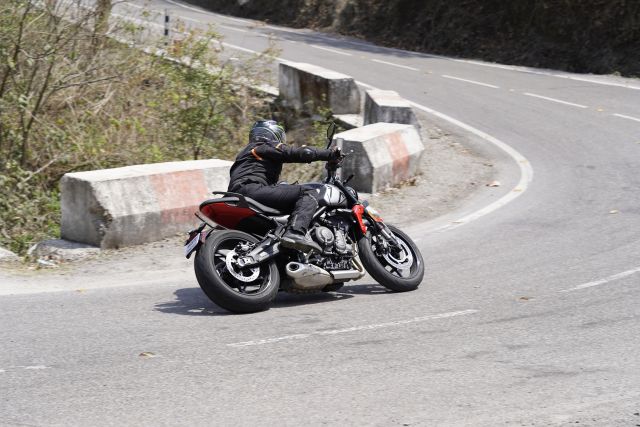
I was especially impressed with how planted and communicative the front felt, always tracking true and giving me the confidence to carry silly speeds into corners. The rear end did occasionally feel a little vague when pushed extremely hard, but the fact is that if you start to approach the limits of the suspension, you are riding way too fast for the street; I know I was. On the flipside, around town and over less-than-perfect surfaces, the suspension soaked up most undulations and kept me insulated from sharp-edged bumps in the road. Coming to the brakes, Nissin two-piston sliding calipers grip 310-mm rotors up front and the system is backed up by steel-braided brake lines to keep fade at bay. Sure you need to be firm on the lever at times, but braking performance is linear, consistent and powerful enough for the streets.
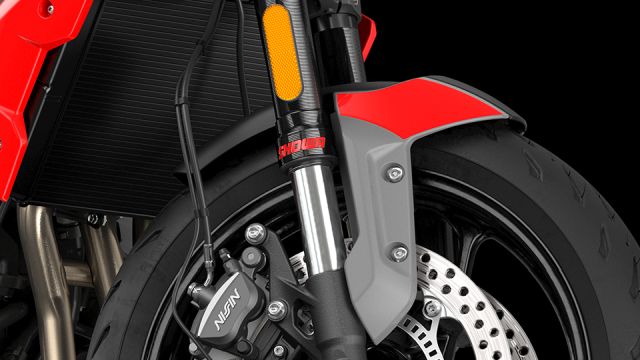
We all know by now that Triumph can build extremely well-balanced, dynamically on-point motorcycles with almost telepathic handling, and the team have put their abilities to excellent use with the Trident. It tips in fast and accurately, helped along by an aggressive 23.9-degree rake angle, and is extremely accommodating of mid-corner line adjustments. The ride-by-wire throttle is perfectly-calibrated, power delivery is linear and seamless, and the bike is equally at home whether cruising along at a relaxed pace or aggressively attacking a twisty ribbon of tarmac. The Street Triple 675 DNA is unmistakeable, whether in the raspy exhaust note or the deliciously-direct steering, and gives the Triumph Trident a pleasantly familiar feel.
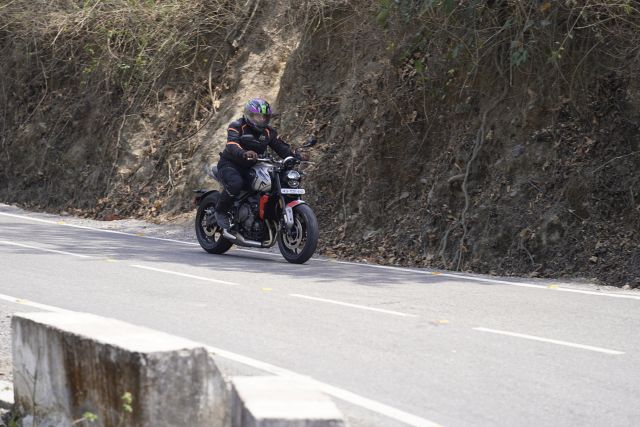
After spending a day and over 220 kilometres with the Triumph Trident I am of the impression that it is a competent, well-balanced roadster that is an absolute riot to ride. Less experienced riders will find it unintimidating and manageable, while even the most experienced will come away smiling. With so many middleweight street bikes making well over 100 hp, the Trident’s 80 ponies may not seem like much, but it’s honestly more than enough, even out on our highways. It is an uncomplicated machine that anybody can just get on, ride and have fun with, and is exciting enough to immediately get one’s blood pumping. I will definitely be recommending it to anyone on the hunt for a sporty naked motorcycle.


Leave a Reply